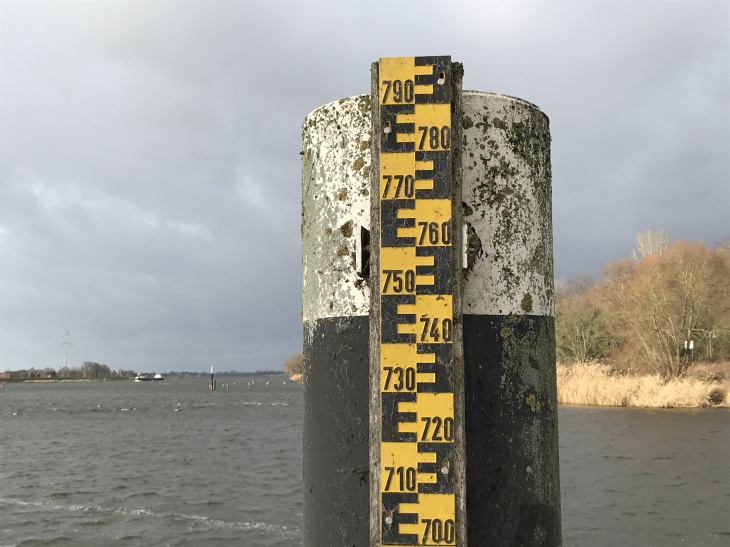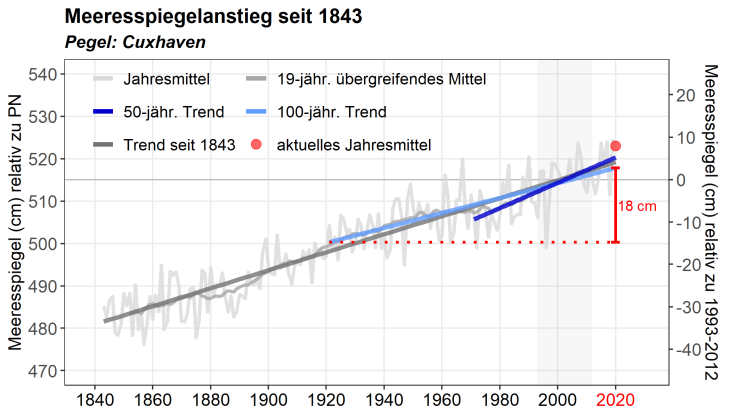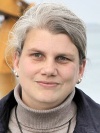Sea levels at the North Sea and Baltic Sea coasts are rising
Please note: Since the 31st of March 2021 the Helmholtz-Zentrum Geesthacht – Center for Materials and Coastal Research has a new name: Helmholtz-Zentrum Hereon. More information www.hereon.de/name
All across the globe, sea levels are rising due to climate change. It is often associated with the fates of people from some far-off regions. However what is the outlook for our coasts? How much has sea level risen in case of the North Sea and Baltic Sea coast in Northern Germany over the last 100 years? Is it rising faster and faster? And what does the future hold? These are the questions that the newly developed the sea level monitor helps to answer, drawing on current sea level data.

The Water Level is rising.Photo: HZG/ Insa Meinke
"Through regular updating of the results, we can now recognize at an early stage whether sea level rise accelerates also picking up speed in our region and how much it might increase if it continues to rise like this”, says coastal researcher Insa Meinke, who developed the monitor together with her colleagues at the Helmholtz-Zentrum Geesthacht (HZG). The monitor is freely available at www.meeresspiegel-monitor.de. It is for all people who live at the coast, make decisions and plan for the long term.
The rise can also be observed at our coasts

In the last 100 years, the sea level in Cuxhaven has risen by about 18 cm on average. Compared to the last 100 years, the current annual sea level is among the highest 5%. Graphic: HZG/ Insa Meinke
In Northern Germany, the rise in mean sea level is one of the most tangible consequences of climate change, one we can already measure. The eight gauges used for sea level monitoring speak for themselves. In fact, analyses of the sea level data confirm that the mean sea level at our coasts has risen by about 15 to 20 cm in the last hundred years (1921 to 2020). This roughly corresponds to the global mean sea level rise over the same period. The majority of gages show the current mean sea level as among the highest since the start of data availability.
No unusual rates of increase in our region so far
For the past decades, the Intergovernmental Panel on Climate Change (IPCC) has reported global mean sea levels rising at increased rate. Although sea levels at the German coasts are currently rising more rapidly compared to the long-term average, there is no evidence of a systematic acceleration. The HZG- scientists chose Husum, Heligoland, Cuxhaven and Norderney (North Sea), as well as Flensburg, Kiel, Travemünde and Warnemünde (Baltic Sea) as their base sites for sea level monitoring.
Early detection of critical trends
The IPCC climate scenarios published in 2019 warn that global mean sea level may rise at an increasingly rapid rate in the future. So, if greenhouse gas emissions are not reduced, a sea level rise of about 60 to 110 cm by 2100 is plausible. If we succeed in significantly reducing greenhouse gas emissions, a global mean sea level rise of 30 to 60 cm is still to be expected by 2100. Since various studies suggest that the rise at our coasts is about the global average, the monitor tells us whether the current values are already harbingers of the IPCC scenarios: "If we extrapolate the rate of current sea level rise at our coasts until 2100, we do not to face the worst case scenario described by the IPCC so far," says Insa Meinke. But this could change. The continuous monitoring of the sea level rise in view of the IPCC scenarios is important for the early detection of critical trends. This way, the necessary measures can be taken in a timely manner.
Related links
- www.sealevel-monitor.eu The Sea Level Monitor by HZG
- www.kuesten-klimabuero.de (only available in German language) Website of the North German Coastal and Climate Office
Contact

Phone: +49 (0) 4152 / 87 - 1868
E-mail contactWebsite
Institute of Coastal Systems - Analysis and Modeling
Helmholtz-Zentrum Geesthacht

Communication and Media
